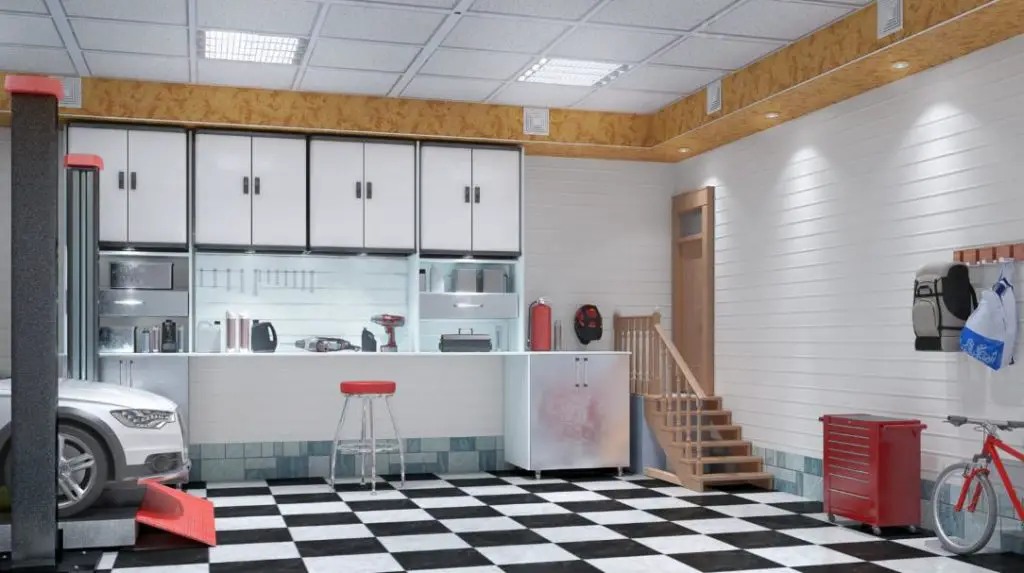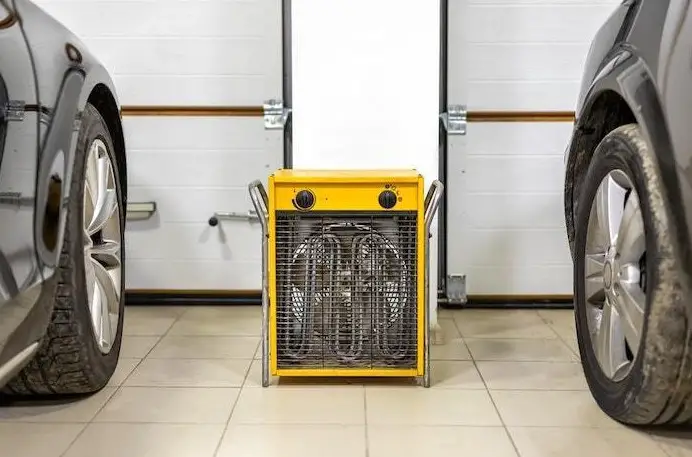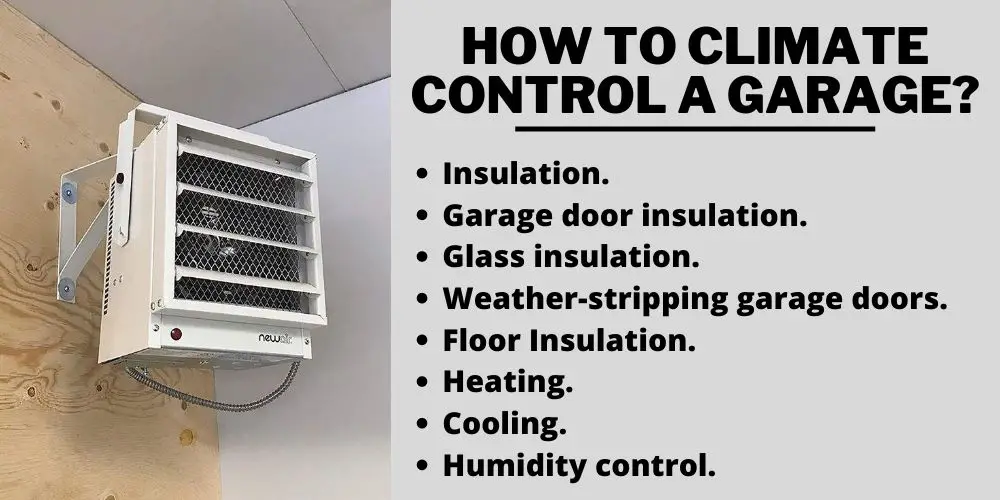With a climate-controlled garage, you can do a lot more than only parking your cars.
Seasons change quickly, but that should not stop you from protecting your garage. By investing in the temperature control of your garage, you are investing in your car’s protection.

If your car is exposed to extreme temperature changes, it might lead to damage, requiring a considerable amount to fix. It’s relatively cost-effective to weatherproof your garage so that your car runs smoothly.
Besides your car, the other things stored in the garage will also be affected due to temperature changes.
Benefits of Weather-Controlling Garages
As mentioned, there are tons of benefits of temperature proofing your garage, but the most significant benefit is for your cars.
In addition to keeping cars, many people these days use the garage for storage, relaxation, rejuvenation, and recreation. Thus climate-controlling garages help with those too.

Many people set up their DIY gym kit in the garage, while many others use the garage for gaming or garage workshop but all these activities require temperature proofing your garage.
- Making the garage a nice place to work, relax by eliminating comfort issues and spend some quality time with friends and family.
- Extending the life of your cars, equipment, battery, and tires.
- Storage of sensitive gear.
- Enhancing the shelf life of garage floors and doors.
- Saving money on electricity bills.
How To Climate Control A Garage: 8 Ways
💁Insulation
Temperature control is one of the most crucial elements of climate-proofing a garage. This is especially important if you live in extremely hot or cold climatic regions. However, weatherproofing a garage is ideal if you live in temperate climates, as temperature changes vary significantly between day and night.
Insulation is one passive tool that helps manage heat flow. If you have insulation in the right places, your energy consumption will reduce automatically.
You May Also Find Useful: Pros and Cons of Insulating Garage

There are various forms of insulation you can use to control your garage temperature. Here’s a guide to proper insulation.
Garage door insulation
There are many garage door insulation kits available in the market; however, the most common ones are:
- Reflective Foil Insulation Panels.
- Expanded Polystyrene Foam Panels (EPS).
- Fiberglass Wool Panels.
The polyester and fiberglass option insulate by reducing the heat transfer by conduction. Reflective Foil, on the other hand, protects by radiating the heat. So, insulated garage doors are really useful.
As a rule of thumb, a high R-value results in better insulation and leads to comfortable temperature.
Glass insulation
Another way to insulate your garage door is through glass panels. A glass door with aesthetically installed glass panels will enhance the look of your garage.
Generally, carriage style and the conventionally raised panel garages have glass panels installed in the topmost section. However, you will have more options if you have a contemporary garage door.
Many people also prefer the float glass option, but that is a poor insulation material.
Insulated glasses have a gap sandwiched between two glass sheets. Additionally, the glass is glazed to reflect any heat.
Weather-stripping garage doors
In addition to insulation, weather stripping also helps seal the heat flow. You have multiple choices of seals for this:
- Bottom seal.
- Bottom threshold seal.
- Door and panel stripping.
- Top and side stripping.
Seals are mostly made of flexible materials like rubber, PVC, and silicone. However, such materials tend to get brittle with time and can get damaged due to mechanical reasons.
Thus it’s essential to check them regularly to ensure they are working well.
Floor Insulation
While you may be doing many things around the walls, doors, and windows of your garage, ignoring the garage floor is not ideal. The garage floor remains cold during winters, and the moisture on the ground below makes it worse.
The cold from below the ground seeps into the concrete flooring and sucks away the heat. Thus insulating the subfloor is crucial. Thankfully there are many insulating tiles available in the market for this purpose.
Besides providing the right amount of insulation, such tiles have a ton of other benefits:
- The air gap technology protects against moisture, mildew, mold, and water leaks.
- The classic tongue and groove design makes insulation a lot more effective.
- Such tiles are solid.
- Air gap technology protects against moisture, mold, mildew, and other small leaks and maintain consistent temperature.
💁Heating
By insulating the garage door and floor, you will be able to trap the heat within in winter months, which is good for a few months. But it is not enough when the outside temperature starts to drop.
In other words, you will need a heater to keep your garage warm during winters.
However, if you think a electric heater or space heater for your garage is unnecessary, think again. The performance of your vehicle may drop due to the extreme cold. With adequate heating, starting your car in the morning will not be time-consuming.
Besides, the engine oil lubricant and coolant will be in the ambient temperature, and the car’s battery life will be extended.
Since most garages these days are an extension of the primary living space, having options for heating will allow you to get some work done with freezing.
You have a few good garage heaters available, and choosing one per your requirement will make your garage comfortable for the chilly winter nights.

💁Cooling
The most basic way to cool the garage is by opening the garage doors for air circulation. However, keep the screen door closed.
You can also use exhaust to push out the hot air in summer season or installing ceiling fan or wall fans in garage may also work and that also a energy efficient option.
While these techniques will work with low heat, for extreme heat, you must consider installing a garage air conditioner. If you have a small garage portable air conditioners are also good option.
Garage cooling will allow you to reduce the cooling cost of the whole house in general.
In fact, garage cooling or air conditioning is essential for your garage storage. If you store things like golf clubs, skis, canoes, and surfboards in your garage. Most of these are manufactured from composite materials and do not react well to heat and humidity. So, you understand how a hot garage may effect you.
Thus, in this case, your best option is to install an air conditioner (window unit also works well in garage). Generally, an 18000 BTU is good for three cars.
Useful: How to Keep a Garage Cool for Dog
💁Humidity control
Indeed humidity makes one uncomfortable, but humidity extremes leads to rusting and corrosion. Thus, high humidity in your garage will affect your cars.
Humidity also impacts concrete. The water condensation due to high humidity can also damage all the items you store in the garage. It can also destroy things made from plastics and break down adhesives.
Garages are not meant for parking cars only. Many people now use this place as a man cave, a home gym, or even a spare room in times of need. Thus, temperature control in this place is crucial.
In this article, we have covered all that is required to make your garage habitable.
I hope you find it helpful.
Contents
